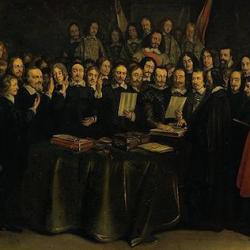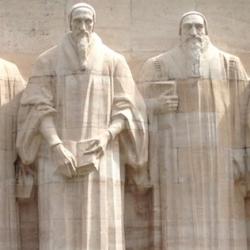K. Luria examines the Sacred Boundaries (xxvii–xxxxi) of early modern France, in an effort to correct extremes of historiography. Some have argued that sacred boundaries between religious groups led to violence; other historians have pointed to continuous interaction between Catholics and Protestants. Both are right. Symbolic boundaries separated Catholic and Protestant, but boundaries were also sites for interaction. Good fences separate neighbors, but also provide a place for neighbors to have conversations.
Luria writes examines three forms of boundary arrangement. The first is the “blurred” boundary, in which “Catholic and Protestant neighbors subordinated religious allegiance to concerns for family alliances, business dealings, and civic affairs.” Specifically, “When parents of one faith chose for their children godparents of the other, or when relatives of one faith participated in the family religious rituals (baptisms, marriages, funerals) of the other, or when Catholics and Huguenots buried their dead side by side in common cemeteries, familial interests overrode a sense of concrete and opposed confessional identities.”
Luria admits that “this type of boundary is the hardest for us to trace because its very indefinability depended on day-to-day, and often unrecorded, sociability. But it was also the product of a certain attitude in which, locally, confessional difference was less important than the tolerance of practical rationality. . . . In certain circumstances, such as when someone made a temporary conversion for the sake of a cross-confessional marriage, it also depended on an understanding of confessional identity as malleable. An individual’s church affiliation could be realigned to suit the social imperatives of family alliances. When this sort of boundary arrangement existed, nonconfessional crosscutting identities were at their strongest, confessional identity was at its weakest, and coexistence was more likely than conflict.”
The second boundary was a “negotiated demarcation between the confessions,” which is what the Edict of Nantes attempted to establish: “In biconfessional communities it promoted a situation in which the difference between the religious groups was clearly recognized and even fostered. Each group’s worship was distinct: Huguenot psalm singing would not interrupt the celebration of the mass; Catholic processions would not pass by temples when Protestants gathered for worship. Sacred space was partitioned. Catholics regained their churches, chapels, and religious houses; Protestant temples might be moved but received an agreed-upon location in the community. Deceased Catholics and Protestants were no longer buried next to each other, but their separate cemeteries remained adjacent in arrangements both sides accepted. Positions on town councils were distributed according to quotas, and local militias enrolled carefully stipulated numbers of Catholics and Huguenots.”
In these negotiated settlements, “confessional groups reached agreements over civic offices, times of worship, cemetery arrangements, and so forth through painstaking negotiations, frequently secured with written contracts.” State power was essential to establishing these negotiated outcomes: “Royal commissioners sent to the provinces to enforce the Edict of Nantes mediated or arbitrated the settlements. The contracts Catholics and Huguenots agreed to spoke of their desire to live in peace ‘under the king’s edicts’ or ‘because the king commanded it.’” But it wasn’t a result of sheer coercion: “No doubt feelings of neighborliness and a desire for civic harmony underlay their negotiations, but we cannot assume that townspeople of the two faiths possessed a simple, natural willingness to get along. Their parleys were often quite strained. Tensions were apparent during the relatively peaceful years of Henri IV’s reign but were even more evident during the two conflict-ridden decades that followed his death in 1610. It was vital for Catholics and Huguenots in biconfessional communities to reach accommodations to avoid violence. Indeed, as France returned to religious war- fare in the 1620s, it became more pressing than ever to do so.”
These sorts of outcomes “did not blur confessional difference; indeed it was underscored and confessional identity made more concrete. But the second form of confessional boundary limited conflict and maintained space in towns for both groups to live and worship. We should not assume that the accords always treated the religious groups equally and with complete fairness to the minority. And no doubt making religious identities clearer could lead to increased hostility and create an essential condition for a harsher and more discriminatory situation. Nonetheless, the boundary was constructed locally, by means of cooperation and accommodation.”
A third type of boundary was one that “separated the groups completely.” These situations “led to the ostracizing of Huguenots in the communities they shared with Catholics. Each church’s effort to differentiate itself from the other and to impose more orthodox standards of belief and observance was an essential part of this process. But neither church was entirely successful. Much more effective in the construction of the third discriminatory boundary was the policy of persecution to which the state turned in the 1630s and then again under Louis XIV.”
Under these circumstances, “the distinctiveness of Huguenots as Huguenots and Catholics as Catholics was promoted over the other social identities they possessed. The old fears of social contamination rematerialized and broke the bonds between people of the two faiths. Protestant cemeteries, temples, and schools were expelled from towns or closed down, and thus symbolically Protestants were deprived of their membership in communities. They were increasingly excluded from guilds, professions, and public posts. They lost the freedom to marry Catholics. Their children were sometimes taken away and placed in Catholic homes and orphanages. Only conversion to Catholicism assured the excluded readmission to their communities. Indeed, we can think of this most persecutory phase of boundary building as having two parts. The first was the enclosing of the minority within the strict confessional boundary that defined Protestant identity narrowly. And the second was the placing of great pressure on Huguenots to recross the rigid boundary by converting to the majority faith.”
Luria’s analysis is a useful antidote to oversimplistic anthropological accounts of Protestant-Catholic relations in early modern France, an antidote that no doubt could be applied beyond France.














